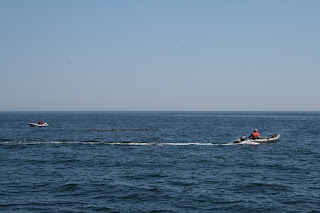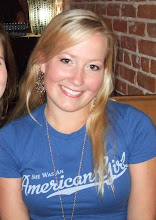Some background: Eiders are the largest ducks in the northern hemisphere. They have several stages of plummage and moult twice a year. Females raise the young without any help from the males. For more detailed information about the common eider, check out the Hinterland Who's Who site here.
This sets the stage for catching eider ducks to band. In late summer, males create large "rafts" offshore and moult their breeding plummage. For 2-3 weeks they cannot fly as they grow back their flight feathers. This is when we target them because otherwise they would just fly away as we approached.
This is where it gets exciting. It's a big operation, including a fishing boat, two zodiacs and a helicopter. The helicopter flies to find the rafts, which can be seen from the air. Then the helicopter radios the fishing boat, which travels to the rafts (you can spot them on the water once you get in the vicinity).
Raft of ducks
Once the fishing boat finds the birds, the zodiacs deploy with two people each. They stay ~180 degrees from each other and circle the eider ducks, forcing them into a tight cluster.
Circling the ducks

Once the ducks are in a dense group, the helicopter flies over the fishing boat and zodiacs, and a gunman (harnessed to the helicopter) shots a net gun into the group, efficiently netting the birds. Each net is packed with an inflatable tube, which is triggered by water. Once the net inflates, a zodiac sweeps in and the person in front drags the net of birds into the boat. The birds are then brought to the fishing boat for processing.
Netting the ducks - they learn fast and start to dive!

On the boat the birds are untangled from the nets and packed into fish crates to await processing. Processing includes sexing (99% are male but you get a few immature females too) and banding birds, which are then released. The aim is to process as quickly as possible so the birds don't spend too much time out of water.
Picking birds from the net

We can learn a lot about eiders by banding them. Duck bands that are recovered elsewhere in the world can tell us what locations they migrate to and their flight paths. Age can also be derived from bands, some of which have been found 20+ years later!
My first banding!

Needless to say, it was an exciting two weeks, and I look forward to helping again next year :)




